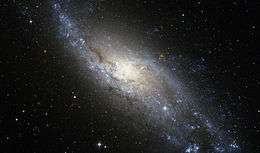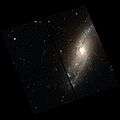NGC 406
| NGC 406 | |
|---|---|
 NGC 406, imaged by Hubble | |
| Observation data (J2000 epoch) | |
| Constellation | Tucana |
| Right ascension | 01h 07m 25.060s |
| Declination | −69° 52′ 45.27″ |
| Redshift | 0.005030[1] |
| Helio radial velocity | 1508[1] |
| Distance | 66.30 ± 6.27 Mly (20.329 ± 1.923 Mpc)[1] |
| Apparent magnitude (B) | 13.02[2] |
| Characteristics | |
| Type | SA(s)c[2] |
| Size | 60,000 ly (18,000 pc) |
| Other designations | |
| ESO 51-18, PGC 3980 | |
NGC 406 is a spiral galaxy quite similar to the well known Whirlpool Galaxy, located some 65 million light-years away,[1] in the southern constellation of Tucana (the Toucan) and discovered in 1834 by John Herschel. It is described in the New General Catalogue as "faint, very large, round, very gradually a little brighter middle".[3] NGC 406 is about 60000 light-years across, roughly half the diameter of the Milky way.
Gallery
 Large Hubble Image
Large Hubble Image
References
- 1 2 3 4 "NASA/IPAC Extragalactic Database". Results for NGC 406. Retrieved 12 February 2017.
- 1 2 "NGC 406". SIMBAD. Centre de données astronomiques de Strasbourg. Retrieved 12 February 2017.
- ↑ "New General Catalog Objects: NGC 400 - 449". cseligman.com. Retrieved 2018-01-23.
External links
- A Cosmic Whirlpool in Tucana — ESA/Hubble Picture of the week
- SIMBAD search results for NGC 406
This article is issued from
Wikipedia.
The text is licensed under Creative Commons - Attribution - Sharealike.
Additional terms may apply for the media files.